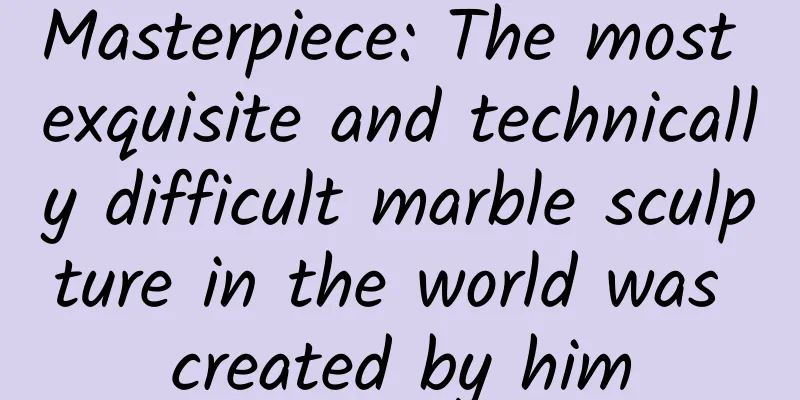Masterpiece: The most exquisite and technically difficult marble sculpture in the world was created by him

|
In "How did he achieve immortal glory while living alone in a foreign land? | The truth in the sea of art", we learned about a sculptor who was hired for life and became famous all over the world on his way back home. So what other works were created by him with superb sculpting skills? This great sculptor, second only to Michelangelo, is also a true hardcore sculpture fan! ——In addition to sculpture, there is more sculpture: he not only creates large sculpture groups, but also is keen on small decorative sculptures. Written by | Zhang Yi 1 The Abduction of the Sabine Women The Rape of the Sabine Women (Ratto delle Sabine) (Fig. 1-1) in the Loggia della Signoria in Florence is Giambologna's masterpiece. It is carved from a single block of marble and is one of the most exquisite and technically difficult sculptures in the world. The entire sculpture is composed of three human bodies that are twisted, entangled and rotated upwards. The whole sculpture is combined to look like a burning flame. There are two men and a woman. The one at the bottom is a frightened old man who almost fell to the ground. He is looking up desperately. Above him is a strong and powerful young man who is holding a young woman and lifting her to the sky. This beautiful woman should be the daughter of the old man at the bottom. Her body looks soft, smooth and lifelike, but she is obviously frightened. She seems to be pushing the young man away with her right hand, as if she is struggling and escaping his grasp, but her left hand is weakly raised upward. Anyone will be deeply shocked by the violent and distorted beauty displayed by this statue. Figure 1-1. Giambologna, The Rape of the Sabine Women, the main body is a marble sculpture with a bronze relief on a base, made between 1574 and 1582, the statue is 410 cm high, and is now on display in the Loggia della Signoria in Florence. Image source: Wikipedia To understand the statue, we need to go back to the historical legend that Romulus founded the ancient city of Rome in 753 BC. According to the Roman historian Livy (real name Titus Livius Patavinus, about 64/50 BC-12/17 AD) in his immortal masterpiece "Ab Urbe Condita" (literally "Since the Founding of the City") written in the late first century BC, Romulus, the founder of Rome and the first Roman king, and the people under his leadership were mostly men. They soon realized that if they wanted to ensure the future of the new country they created, they needed to have many children. But there were very few women here at that time. According to Livy, Romulus and his men first negotiated with the neighboring Sabines, hoping that they would encourage Sabine women to marry into Rome. But the Sabines were skeptical about this. They were worried that if the Roman population grew too much, it would pose a threat to them, so they refused to let their women go to Rome. After the peace attempt failed, they decided that if the Sabine women did not want to marry and come to Rome, they would use force to abduct them. Romulus then set up a trick and invited the Sabines and other neighboring tribes to participate in a festival to commemorate the sea god Neptune. When the celebration was going on, Romulus suddenly gave a signal, and the Romans forcibly abducted the Sabine women. The sudden violence made the Sabine men angry but powerless, and they were also driven out of Rome. The sculptor Giambologna’s work seeks to depict this crucial moment in the Roman legend. A closer look at Giambologna’s work shows three representative figures: the Sabine woman struggling upward to free herself from a young Roman kidnapper, while the Roman kidnapper, standing with legs apart, is stepping over a cowering, helpless old Sabine man, who may be the father of the kidnapped woman. Viewing this sculpture from any angle, people will get an extraordinary feeling. From one angle, we can see the Roman’s hand sinking into the plump and soft flesh of the Sabine woman’s back as he grabs her (Fig. 1-2); from another angle, we can see the pain and panic on the woman’s face as she tries to escape (Fig. 1-3); from another angle, we can also see the energy emitted by the three people’s bodies twisted and entangled together. The viewer can watch the entire sculpture from any angle and will be deeply attracted by the artistic tension it displays. Another interesting thing is that the eyes of the statue of Neptune, the god of the sea, shown in Figures 2-1 and 2-4 in "How did he achieve immortal glory in a foreign land?" are exactly where the sculpture of the Rape of the Sabine Women is located, as if the god of the sea is silently watching the Romans set up tricks and commit atrocities in his name. Figure 1-2. Giambologna, the abduction of the Sabine women | Image source: Wikipedia Figure 1-3. Giambologna, the abduction of the Sabine women | Image source: Wikipedia Such a complex sculptural group would normally be carved into separate parts and then joined together, but Giambologna carved it from a single block of marble. No doubt the sculptor was demonstrating his superior marble sculpting skills and attempting to surpass the ideals of ancient Greco-Roman sculpture. According to Pliny the Elder’s description in Natural History, the famous ancient Greek sculpture group Laocoön and His Sons (Fig. 1-4) and the Farnese Bull (Fig. 1-5) were made of a single piece of marble. Although people knew that Laocoön was not made of a single piece of marble after it was unearthed in Rome in 1506, and that the Farnese Bull unearthed in 1546 was a replica from the Roman Empire in the early third century AD, Pliny’s description naturally aroused the creative passion of the greatest sculptors of the Renaissance. At the age of 72, Michelangelo once tried his best sculpture on the theme of Lamentation over Christ. He used a single piece of marble to sculpt four figures at the same time, and the sizes of these sculptures were at least the same as the real bodies of real people. However, for various reasons, no one, including Michelangelo himself, considered his work to be completely successful. Careful readers can carefully observe Figure 1-6 to see if they can find the left leg of the crucified Jesus. Giambologna was naturally inspired by Pliny's theory. He designed his work as a group sculpture of three natural human bodies, but at the same time he had to solve another problem that sculptors since the Renaissance have tried to solve, that is, how to make the sculpture show its artistic perfection from all different angles. Giambologna's attempt was undoubtedly very successful. In terms of sculpture technology, he not only surpassed the works of the legendary ancient Greek and Roman sculptors, but also surpassed the achievements of his Renaissance predecessors. Figure 1-4. Laocoön group sculpture, marble; height 208 cm, width 163 cm, depth 112 cm; Roman replica, the original was made by three sculptors, Agesander, Athenedoros and Polydorus, from the ancient Greek island of Rhodes around the 2nd century BC, now on display in the Vatican Museum | Image source: Wikipedia Figure 1-5. Farnese Bull, a replica of an ancient Greek sculpture from the Roman Empire, a marble sculpture made in the early third century AD, more than 4 meters high, about 3.3 meters wide and deep, now on display at the Naples Archaeological Museum in Italy | Image source: Wikipedia Figure 1-6. Michelangelo, Lamentation over Christ, marble, made around 1547-1555, height 226 cm, Florence Cathedral Museum | Image source: Wikipedia Another interesting fact that must be mentioned is that Giambologna had no intention of depicting the conflict between the Romans and the Sabines, nor did he have any intention of depicting the abduction of women in the initial stage of creating this group of sculptures. He initially just wanted to show his skills by depicting the complex and anatomically perfect human body. It was not until Grand Duke Francesco decided to place this work in the Loggia della Signoria to show it to the world together with Michelangelo's David and Benvenuto Cellini's Perseus that the statue was named The Rape of the Sabine Women. It is said that it was also considered to be named Paris and Helen, Pluto and Proserpina, etc. In order to highlight the name of the abduction of the Sabine women, the sculptor also specially created a relief with the same theme for the base where the sculpture was placed (Figure 1-7) to enhance people's recognition and understanding of it. Figure 1-7. Giambologna, The Rape of the Sabine Women, bronze relief, made in 1579, 75 cm high and 90 cm wide, now on display in the Loggia della Signoria in Florence | Image source: Wikipedia Over time, some people today rudely refer to this sculpture as "The Rape of the Sabine Women", but Giambologna did not use the word rape. The original name of the sculpture was Ratto delle Sabine, which means kidnapping and forcible abduction of the Sabine women, and does not mean forced sexual intercourse. Due to the changes in Italian and the misleading English translation, Giambologna's work has been given some thoughtless names, making us mistakenly think that it is a statue depicting a man sexually assaulting a woman. This sculpture only represents a moment in history, so placing it in the Loggia della Signoria in the Piazza Vecchio in Florence, like other sculptures in the square, obviously had political considerations of the rulers. For this reason, we should look at the subsequent story in Roman history. Roman historian Livy had a relatively peaceful view of the conflict between Rome and Sabine. According to his records, no woman was forced to marry a Roman or raped. The Roman King Romulus personally pleaded with each woman to join them in creating the new country of Rome, allowing them to freely choose their husbands and give them property. This attitude towards women was extremely rare at the time. But the Sabine men could not forgive this. They continued to fight with the Roman men, hoping to wash away the shame of their tribal women being robbed, until finally these captured Sabine women felt that they had to do something to stop the tragedy of the constant war between the two countries. During a battle, they ran into the battlefield with their children born to Roman men and called on their husbands and fathers to stop the bloody conflict. This was a great attempt, and their Sabine fathers and brothers and Roman husbands finally laid down their arms and declared peace. Romulus kindly invited the Sabine King Titus Tatius to lead the Sabine people to live in Rome and rule together, and Rome became a common country between the Roman and Sabine peoples. After the death of Titus Titus and Romulus, Rome elected its second king, a Sabine named Numa Pompilius (753-673 BC), on the recommendation of the Roman Senate. During Numa's reign, Rome entered a long period of peace. This king brought a calendar to Rome and established an open and inclusive religious system, laying the foundation for Rome's eventual prosperity. In 1574, Grand Duke Cosimo I de' Medici of Tuscany died, and his eldest son Francesco I de' Medici (1541-1587) successfully inherited his title and ruling power and became the second Grand Duke of Tuscany. This was a peaceful transfer of power without bloodshed. All parties in Florence, including republicans who opposed the Medici family, finally accepted the legitimacy of the Medici rule based on various considerations. More importantly, the emerging bourgeoisie headed by the Medici family finally reached a compromise with the traditional ruling class of Europe, including the secular blue-blooded princes and nobles and the Catholic Church, through peaceful means and became part of the ruling class. The emerging bourgeoisie not only injected fresh blood into the traditional European ruling class, but also brought them new humanistic concepts and the accompanying lifestyle, including humanities and art; but they also gave up the challenge to traditional feudalism to a certain extent, accepted the traditional ruling method to a considerable extent and used this method to join the ruling class; the traditional European ruling class judged the situation and finally recognized the power of capital. They finally opened their arms and welcomed the bourgeoisie represented by the Medici family into their camp. After more than a century of exploration, struggle and struggle, Florence finally ushered in nearly 200 years of peace and tranquility. The Medici hoped that the Duchy of Tuscany, centered on Florence, would become a community of shared destiny, where they could live together with those who opposed the Medici family for the common prosperity and wealth, just like Rome, which was jointly composed of the Romans and the Sabines, and eventually become a glorious and powerful country, where the people enjoyed freedom, happiness and civilization within the framework of fair laws. This sculpture group placed in the Galleria dell'Armes was the promise made by Grand Duke Francesco I to the people of the Duchy of Tuscany. However, people should note that to the right rear of the sculpture of the abduction of the Sabine women there is a sculpture of Hercules and Tao made by Giambologna (Figure 1-8). The Medici family in power was not weak. They were believers in Machiavelli's theory and would not hesitate to fight back against any force that dared to challenge them. Figure 1-8. Giambologna, Hercules and Tao, marble sculpture, made in 1600, 269 cm high, now on display in the Loggia della Signoria in Florence | Image source: Wikipedia After carefully appreciating the violent and twisted beauty displayed by Giambologna in his sculpture The Rape of the Sabine Women, if we turn our heads and look to the left at David on the left side of the main entrance of the Palazzo Vecchio, this giant created by Michelangelo in the early 16th century is quietly accumulating strength and trying to hit Goliath with one blow. By comparing the two, we can appreciate the tremendous changes in artistic tastes during the development of the Renaissance in the first 70 years of the 16th century. 2 Bronze equestrian statue of Cosimo I After completing the Rape of the Sabine Women, Giambologna turned his interest to another type of large-scale monumental public sculpture - bronze equestrian statues. In the Renaissance and the following centuries, only countries with very strong comprehensive strength could cast large bronze equestrian statues, because bronze could be used to cast weapons and was relatively expensive. Only wealthy countries had the financial resources to support such projects. In addition, the technology at that time made it relatively long to cast bronze equestrian statues, so it required a relatively stable country's politics and no fierce internal and external wars. The most famous example of failure was that Leonardo da Vinci had accepted a project to cast a bronze equestrian statue for the Sforza family, the rulers of Milan, but it failed. One of the important reasons was that Milan was involved in a war with France. In the 15th century, Italy only cast two large bronze equestrian statues. Their sculptors were Donatello and Verrocchio, two great sculptors of Florence, but the statues were both in the territory of the powerful maritime empire, the Republic of Venice. After becoming the hereditary Grand Duke of Tuscany, the Medici family adopted a combination of peace and war, coupled with wise and reasonable domestic and foreign policies, making Tuscany a stable, prosperous and peaceful country, and finally enabling Florence to have the strength to create a bronze equestrian statue that symbolizes national strength. As the founder of the Grand Duchy of Tuscany, Grand Duke Cosimo I de' Medici, his lifelong civil and military achievements have been tested after his death, and it is indeed worthy of future generations to cast a bronze equestrian statue for him, which was only enjoyed by kings who won great victories in foreign wars in ancient Rome. The bronze equestrian statue (Figure 2-1 and Figure 2-2) commissioned by Giambologna for the third Grand Duke of Tuscany, Ferdinando I de' Medici (1549-1609) is the first in Florence and the third in Italy since the Renaissance. It is a summary of the sculptor's lifelong experience. The horse's right front hoof is raised high and the left hind hoof is lightly raised to move forward. The horse's muscles are tight and the tendons and blood vessels are clearly visible. The sculptor vividly shows the strength of the war horse in this work; Cosimo I, riding on horseback, proudly turns his head slightly to look at the Piazza Vecchio and the Uffizi Palace next to it. This place is not only the core of the country he founded, but also displays many public sculptures. They are the pride of the Medici family. It was with the Medici family's continued sponsorship that the new art form produced by the Florentine Renaissance spread throughout Europe. Figure 2-1. Giambologna, bronze equestrian statue of Cosimo I, made between 1587 and 1594. The statue itself is 450 cm high and is now on display in the Piazza Vecchio in Florence. Image source: Wikipedia Figure 2-2. Giambologna, bronze equestrian statue of Cosimo I | Image source: Wikipedia Giambologna's bronze equestrian statue of Cosimo I was so successful that he cast another bronze equestrian statue for Grand Duke Ferdinando I de' Medici in Piazza della Santissima Annunziata in Florence in the early 17th century. This statue was completed with the help of his student and assistant Pietro Tacca (1577-1640) (Figures 2-3). Figure 2-3. Giambologna, bronze equestrian statue of Ferdinand I, made between 1602 and 1607, now on display in Piazza Vecchio in Florence | Image source: Wikipedia It is worth noting that the bronze equestrian statue made by Giambologna later became a model for bronze equestrian statues of kings in various European countries. The bronze equestrian statues made in the squares of various European cities, symbolizing the authority of the king, all largely adopted the paradigm established by Giambologna. 3 Small indoor bronze statue In addition to his large monumental public and decorative sculptures, Giambologna was also keen on designing and producing smaller bronze sculptures for interior decoration, some of which were adapted from his larger sculptures, while many were entirely new creations. The subjects of these small sculptures are extremely wide, including not only figures but also various animal works. These small sculptures were used as diplomatic gifts by the Medici court and presented to kings and nobles of various European countries. Due to their small size and the small amount of bronze used, these small sculptures were also favored and sought after by wealthy civilians and the intellectual class, thus opening the way for popularizing the sculptor's works. Through small indoor bronze sculptures, Giambologna widely spread his lifelong sculptural achievements and reputation, and greatly influenced the sculptural style of later generations, especially Baroque sculpture. These small sculptures are still being copied to this day and have become precious collections for sculpture art lovers. We put some photos of small sculptures here without introduction for readers to appreciate (Figure 3-1, Figure 3-2 and Figure 3-3). Figure 3-1. Giambologna, Flying Mercury, a small bronze sculpture, made in the 16th century, 52.5 cm high, now on display in the Hermitage Museum in St. Petersburg, Russia | Image source: Wikipedia Figure 3-2. Giambologna, Bathers, bronze statue, made in 1565, 25 cm high, now on display at the Kunsthistorisches Museum in Vienna, Austria | Image source: Wikipedia Figure 3-3. Giambologna, Symbol of Astronomy, gilded bronze, made around 1573, 39 cm high, now on display at the Kunsthistorisches Museum in Vienna, Austria | Image source: Wikipedia 4 A brief conclusion Although he was born in Flanders, Giambologna undoubtedly made his career as a sculptor in Florence. In the two or three centuries after his death, many people considered him to be the greatest sculptor of the Renaissance, second only to Michelangelo. Although his reputation may not be as loud as it was in the 17th and 18th centuries as people's artistic tastes change, he is still one of the greatest sculptors of the Renaissance, and together with Donatello, Verrocchio, Michelangelo, Bernini and Canova, he will forever shine in the history of Italian and even human sculpture. About the Author Zhang Yi is an art historian, consultant to the Clock and Ancient Musical Instruments Department of the Hermitage Museum in Russia, consultant to the French Pendulum Clock Gallery, consultant to the Guangdong Clock Collection Research Professional Committee, and also a mathematician and logician. Special Tips 1. Go to the "Featured Column" at the bottom of the menu of the "Fanpu" WeChat public account to read a series of popular science articles on different topics. 2. Fanpu has opened the function of searching articles by month. Follow the official account and reply with the four-digit year + month, such as "1903", to get the article index of March 2019, and so on. Copyright statement: Personal forwarding is welcome. Any form of media or organization is not allowed to reprint or excerpt without authorization. For reprint authorization, please contact the backstage of the "Fanpu" WeChat public account. |
<<: Beware! Be careful when you have "red eyes" like this! Severe cases may cause blindness...
>>: How did the ancients prevent fire during the Qin and Han dynasties?
Recommend
Google just released a tool to crack into your iPhone
Google released a powerful tool this morning to h...
Mistakenly thought it was a cold, and almost lost my life! Don’t ignore these situations...
Have you ever had this experience when you had a ...
Science in the spotlight this week | Desert lakes seen from space
1. Desert lakes seen from space Recently, my coun...
Mozilla: We have an advantage over Microsoft in the mobile operating system market
Mozilla is an open source Internet software compa...
Which is bigger, 9/11 or 9/9? A question that a kindergarten kid can answer stumps a bunch of AIs…
Which one is bigger, 9.11 or 9.9? This question, ...
How to write a promotional copy that goes viral with product thinking
When we see a good product review article, we oft...
The most detailed explanation of Toolbar development in history, this is a must-read!
Introduction to Toolbar Toolbar is a new control ...
A hero’s origins are not important, and the image of the saint is very different: What does he want to express through these two works?
Donatello, who invented the layered carving techn...
3 tips for paid APP promotion!
Last year, I had an interesting work experience. ...
"In the wild, I think of myself as a man"! In the Chinese Academy of Sciences, there is such a "her" force
Author: Chen Huanhuan Cai Yuanpei once said in a ...
Which company providing SEO optimization services in Yancheng is better? How to choose?
Nowadays, due to the increasing bidding costs, ma...
91 Ten Articles: LG Magna will trial mass production of cars for Apple, Baidu and Didi obtain autonomous driving licenses
1. Hongguang MiniEV ranked third in the March new...
Where in China is the best preserved meat?
Mixed Knowledge Specially designed to cure confus...
Huawei Chairman: Android is still the first choice. Whether Hongmeng will be used in mobile phones has not yet been determined.
On July 12, at Huawei's "2018 Sustainabi...
Mantou New Media Operation Certificate Class
A millionaire trader will teach you the core skil...









